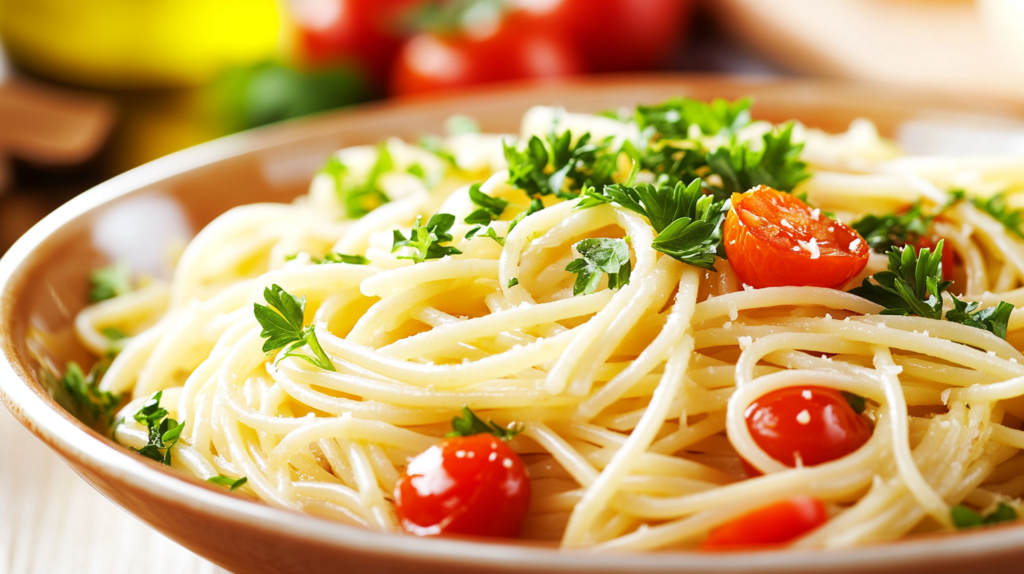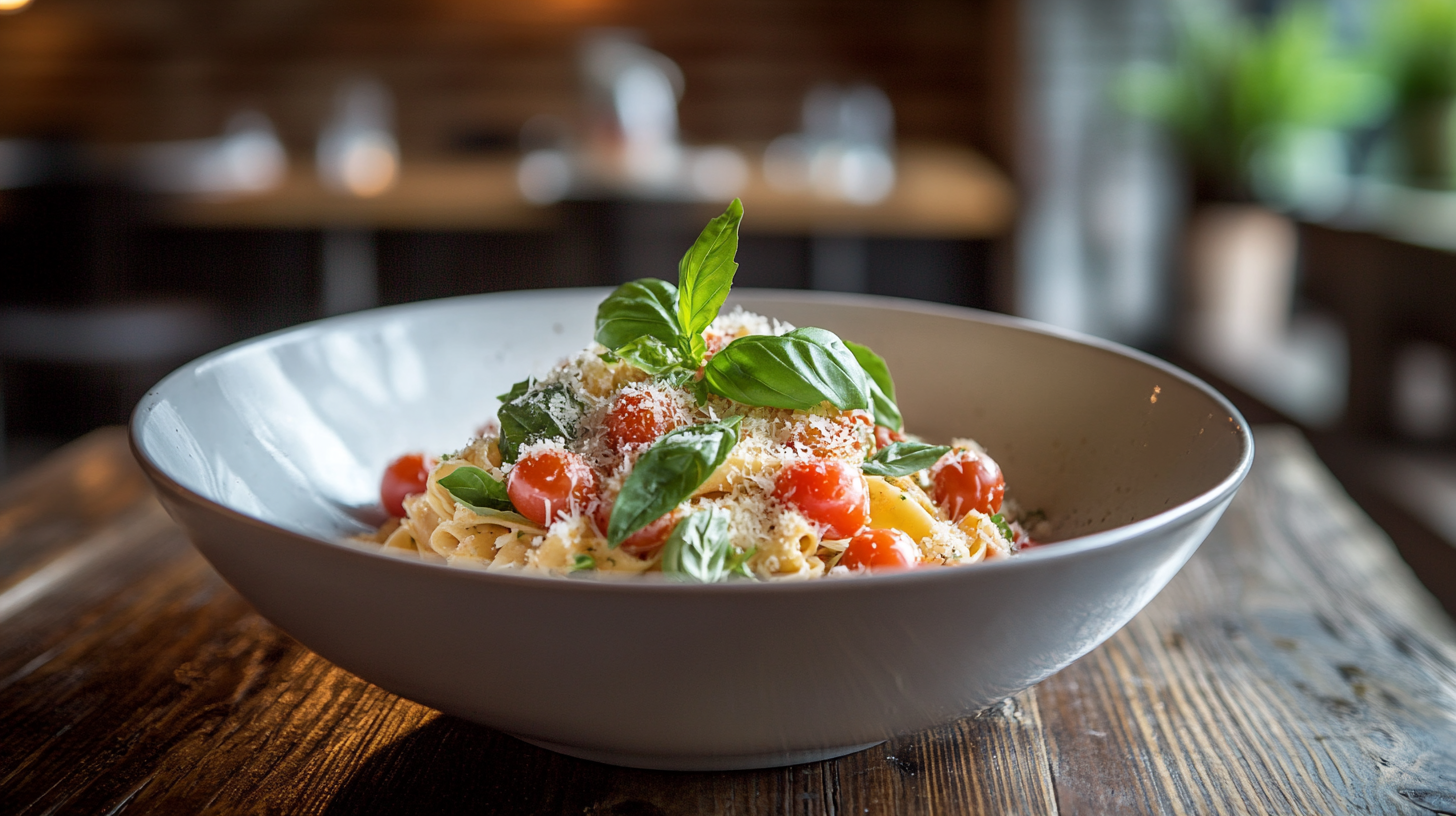Table of Contents
Who doesn’t love a warm, comforting bowl of pasta? But what if you’re avoiding gluten? Whether it’s due to celiac disease, gluten sensitivity, or simply a lifestyle choice, the good news is that you don’t have to give up pasta altogether. Enter the best gluten-free pasta recipe your delicious, wheat-free pasta alternative!
In this guide, we’ll take you step-by-step through everything you need to know about creating the perfect gluten-free pasta recipe right in your kitchen. From homemade gluten-free pasta dough to troubleshooting common problems, this article has you covered. So, let’s dive in and explore the art of making gluten-free pasta that’s both tasty and satisfying!
Why Go Gluten-Free? Health Perks and Dietary Essentials Uncovered
You may be wondering, “What’s the big deal about gluten-free pasta?” Well, it’s more than just a trendy buzzword. For many people, gluten-free diets are a necessity rather than a choice.
Who Needs Gluten-Free Pasta?
- Celiac Disease Sufferers – Gluten can damage the small intestine of those with celiac disease, leading to nutrient deficiencies and other health issues.
- Gluten Sensitivity – Even without celiac disease, some individuals experience bloating, headaches, or fatigue after consuming gluten.
- Health-Conscious Eaters – Many people adopt gluten-free diets to reduce inflammation or improve digestion.
“Gluten-free pasta isn’t just a substitute; it’s an opportunity to explore new flavors, textures, and ingredients that traditional pasta can’t offer.”
Health Benefits of Gluten-Free Pasta
- Better Digestion – Gluten-free pasta can ease bloating and digestive discomfort.
- Rich in Nutrients – Depending on the flour used, gluten-free pasta can be high in protein, fiber, and minerals.
- Weight Management – Some types of gluten-free pasta have fewer calories than traditional pasta, making it a great option for those watching their weight.
Essential Ingredients for Gluten-Free Pasta Dough

Before we start mixing and kneading, let’s break down the essential ingredients you’ll need to create the perfect gluten-free pasta dough.
Flour Options for Gluten-Free Pasta: Which One Works Best?
Choosing the right flour is like picking the perfect paint for your masterpiece it’s the foundation of your recipe. Here are some popular options:
| Flour Type | Properties |
|---|---|
| Almond Flour | High in protein, slightly nutty flavor, works well with eggs as a binder. |
| Brown Rice Flour | Mild flavor, good structure, but needs blending with other flours. |
| Chickpea Flour | Dense and high in protein, adds a savory flavor to pasta. |
| Tapioca Flour | Adds elasticity and chewiness, ideal for blending with other flours. |
| Sorghum Flour | Mild and slightly sweet, provides a smooth texture. |
| Potato Starch | Lightens the dough and enhances softness. |
Pro Tip: Use a blend of 2–3 flours for the best texture and taste. Store-bought gluten-free flour blends also work well if you’re short on time.
Binding Agents: The Secret to Elastic and Firm Pasta Dough
One common challenge with gluten-free pasta dough is its tendency to crumble. This is where binding agents save the day!
- Eggs – Naturally provide structure and moisture.
- Xanthan Gum – Mimics gluten’s elasticity. Add about 1 teaspoon per cup of flour.
- Psyllium Husk Powder – Adds fiber and prevents cracking.
“Think of binding agents as the glue that holds your gluten-free pasta together!”
Step-by-Step Gluten-Free Pasta Recipe: From Dough to Delicious Dish
Now for the fun part making the pasta!
Mixing and Kneading the Perfect Dough: Tips and Tricks
Here’s the basic recipe you’ll follow:
Ingredients:
| Item | Quantity |
|---|---|
| Gluten-Free Flour Blend | 2 cups |
| Eggs | 3 large |
| Olive Oil | 1 tablespoon |
| Salt | 1/2 teaspoon |
| Xanthan Gum (if needed) | 1 teaspoon |
| Water | As needed |
Instructions:
- Combine Dry Ingredients: In a large bowl, mix the flour, salt, and xanthan gum.
- Make a Well: Create a hole in the center of the flour and crack in the eggs. Add olive oil.
- Mix Slowly: Gradually incorporate the flour into the eggs, forming a sticky dough.
- Knead the Dough: Move it to a floured surface and knead for about 5–7 minutes until smooth. Add water in tiny increments if too dry.
- Rest the Dough: Wrap it in plastic and let it rest for 20–30 minutes to improve elasticity.
Shaping Gluten-Free Pasta: Techniques for Beautiful Results

Once rested, it’s time to shape your dough into pasta!
- For Fettuccine or Tagliatelle: Roll the dough into a thin sheet (about 1/8 inch thick) and cut into strips.
- For Ravioli: Roll out two thin sheets, place filling on one, and cover with the other. Seal the edges tightly.
- For Spaghetti: Use a pasta machine or a spaghetti cutter for uniform strands.
Pro Tip: Dust the cut pasta lightly with flour to prevent sticking while working.
Cooking Gluten-Free Pasta Like a Pro: Avoiding Mushy or Sticky Textures
Cooking gluten-free pasta can feel like walking a tightrope it’s easy to overcook or undercook. But don’t worry, here’s how to master it:
Boiling Tips for Gluten-Free Pasta to Get Perfect Texture Every Time
- Boil Generously Salted Water – Add 1 tablespoon of salt per liter of water.
- Cook Al Dente – Gluten-free pasta cooks faster than regular pasta, so check it 1–2 minutes before the package time.
- Stir Frequently – Gluten-free pasta loves to stick. Stir within the first minute of cooking.
- Rinse with Warm Water – Unlike traditional pasta, gluten-free varieties benefit from a quick rinse to remove starch residue.
Common Mistakes and How to Fix Them While Cooking Gluten-Free Pasta
- Mushy Pasta? Reduce cooking time or drain it immediately after it reaches al dente.
- Sticky Pasta? Add a teaspoon of olive oil while cooking and stir gently.
- Breaks Apart? Double-check the dough’s moisture level before shaping.
Sauces and Toppings That Complement Gluten-Free Pasta Recipe Perfectly
Now that we’ve mastered making and cooking gluten-free pasta, it’s time to dress it up! The right sauce can elevate your dish from ordinary to extraordinary. Whether you’re craving something rich and creamy or light and fresh, there’s a perfect match for every mood.
Classic Tomato-Based Sauces: Rich Flavors for Any Occasion
Tomato sauces are timeless, and the acidity pairs beautifully with gluten-free pasta.
Popular Options:
- Marinara Sauce – A simple blend of tomatoes, garlic, and basil. It’s quick, hearty, and versatile.
- Arrabbiata Sauce – Love spice? This fiery sauce adds a kick with red pepper flakes.
- Bolognese Sauce – A rich meat-based sauce perfect for thicker pasta shapes like penne or rigatoni.
“Pro Tip: Use fire-roasted tomatoes for a smoky depth of flavor.”
Creamy Alfredo and Cheese Sauces: Indulgent and Satisfying Pairings
If you’re in the mood for something indulgent, creamy sauces are your best bet.
- Alfredo Sauce – Made with butter, cream, and Parmesan, this sauce is pure comfort.
- Cheese Sauces – Combine sharp cheddar, Gruyère, or gouda for a gooey, irresistible dish.
Pair these sauces with fettuccine or linguine for the best results!
Vegetable-Infused Sauces for a Healthy Twist
Health-conscious? No worries vegetable based sauces bring flavor without the guilt.
- Pesto Sauce – Made with basil, garlic, pine nuts, and olive oil, this vibrant sauce is packed with nutrients.
- Roasted Red Pepper Sauce – Sweet, smoky, and creamy when blended with cashews.
- Zucchini or Spinach Puree – A light and healthy option for picky eaters.
Vegan and Dairy-Free Alternatives for Gluten-Free Pasta Lovers
What if you’re avoiding dairy or following a plant-based diet? Good news—there are plenty of vegan options that pair wonderfully with gluten-free pasta!
Plant-Based Ingredients to Elevate Your Gluten-Free Pasta Dish
Cheesy Flavors Without Dairy:
- Nutritional Yeast – Adds a nutty, cheesy flavor without any dairy.
- Cashew Cream – Blend soaked cashews with garlic and lemon juice for a silky texture.
Protein Boosters:
- Chickpeas or lentils for added texture.
- Tofu or tempeh, marinated and pan-fried, to keep the dish filling.
“Tip: Blend roasted cauliflower and garlic for a dairy-free Alfredo sauce alternative!”
Troubleshooting Gluten-Free Pasta Dough: Common Problems and Solutions
Making gluten-free pasta can sometimes feel like solving a puzzle. But don’t worry here’s how to handle the most common issues.
Why Is My Dough Too Dry or Too Sticky? Quick Fixes Explained
Dry Dough?
- Add water one teaspoon at a time until it softens.
Sticky Dough?
- Sprinkle a little more flour and knead gently to avoid overworking it.
How to Prevent Gluten-Free Pasta from Breaking During Cooking
- Rest the Dough Longer – Let it sit for 30 minutes to improve elasticity.
- Don’t Overcook – Gluten-free pasta is delicate, so cook just until al dente.
- Handle with Care – Use a slotted spoon to lift pasta out of the pot instead of dumping it all at once.
Storing and Freezing Gluten-Free Pasta: Keep It Fresh for Longer
Made a big batch? No problem! Gluten-free pasta can be stored for later use.
Best Practices for Storing Uncooked Gluten-Free Pasta
- Refrigeration: Wrap fresh dough in plastic and store it for up to 2 days.
- Freezing: Freeze pasta shapes on a tray before transferring them to airtight bags. Keeps for 2–3 months.
Freezing Cooked Pasta Without Losing Its Flavor or Texture
- Toss cooked pasta with olive oil to prevent sticking.
- Freeze in portion-sized containers for quick meals.
“Pro Tip: Always reheat frozen pasta in simmering water or sauce to restore its texture.”
Health Benefits of Gluten-Free Pasta: Is It Really Better for You?
You might be wondering is gluten-free pasta actually healthier? Well, it depends on your dietary goals!
Key Benefits:
- Lower in calories and carbs compared to traditional pasta.
- High in fiber and protein, especially chickpea or quinoa-based varieties.
- Ideal for those with gluten intolerance or allergies.
Gluten-Free Pasta for Kids: Fun Shapes and Flavors to Make Mealtime Exciting
Kids can be picky eaters, but gluten-free pasta can be just as fun and tasty as regular pasta!
Tips to Encourage Kids to Enjoy Gluten-Free Meals
- Use Fun Shapes: Stars, spirals, and bow ties make pasta fun to eat.
- Colorful Veggies: Add vibrant ingredients like cherry tomatoes and spinach for visual appeal.
- Cheesy Sauces: Most kids love cheese try dairy-free options for sensitive stomachs.
“Involve kids in the cooking process it’s a great way to make mealtime exciting!”
Serving Ideas and Presentation Tips for Gluten-Free Pasta Dishes

Presentation matters! Here’s how to make your dishes Instagram-worthy:
Plating Techniques to Impress Guests with Homemade Gluten-Free Pasta
- Stack It High: Create height with layers of pasta, sauce, and garnishes.
- Garnish with Fresh Herbs: A sprinkle of basil or parsley adds a pop of color.
- Use Fancy Plates: Elegant dishes make any meal feel special.
Frequently Asked Questions About Gluten-Free Pasta Recipe
Is Gluten-Free Pasta Healthier Than Regular Pasta?
It can be, especially when made with nutrient-dense flours like quinoa or chickpea. However, always check the labels for added preservatives.
Can You Make Gluten-Free Pasta Without Eggs?
Absolutely! Replace eggs with flaxseed meal (1 tablespoon mixed with 3 tablespoons water). It works as a great vegan binder.
Conclusion: Embrace Healthy and Delicious Gluten-Free Pasta Recipe in Your Kitchen
And there you have it—everything you need to know about making gluten-free pasta from scratch! Whether you’re looking for a healthier alternative, dealing with dietary restrictions, or just exploring new recipes, gluten-free pasta can be a game-changer.
So, what are you waiting for? Grab your apron, roll up your sleeves, and start cooking! And remember—experimentation is part of the fun. Don’t be afraid to mix and match flours, sauces, and toppings until you find your perfect combination.
“Because food isn’t just about feeding your body; it’s about nourishing your soul.”

